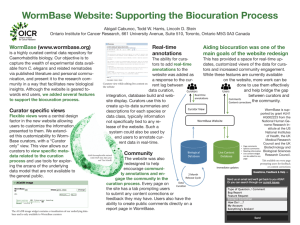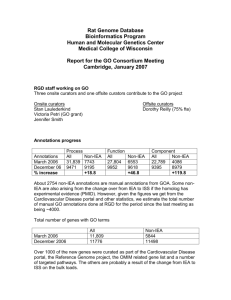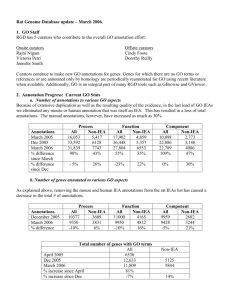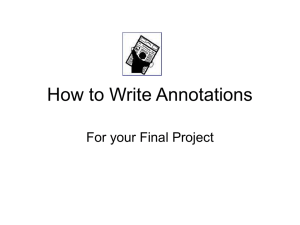WormBase-Dec2007 - Gene Ontology Consortium
advertisement
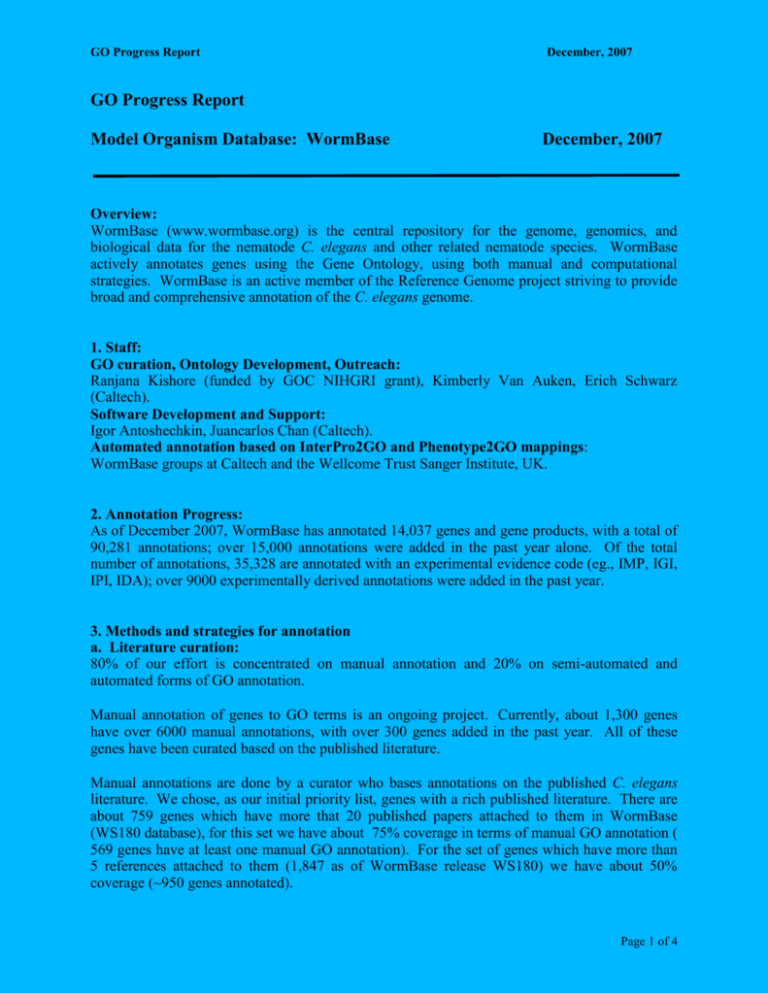
GO Progress Report December, 2007 GO Progress Report Model Organism Database: WormBase December, 2007 Overview: WormBase (www.wormbase.org) is the central repository for the genome, genomics, and biological data for the nematode C. elegans and other related nematode species. WormBase actively annotates genes using the Gene Ontology, using both manual and computational strategies. WormBase is an active member of the Reference Genome project striving to provide broad and comprehensive annotation of the C. elegans genome. 1. Staff: GO curation, Ontology Development, Outreach: Ranjana Kishore (funded by GOC NIHGRI grant), Kimberly Van Auken, Erich Schwarz (Caltech). Software Development and Support: Igor Antoshechkin, Juancarlos Chan (Caltech). Automated annotation based on InterPro2GO and Phenotype2GO mappings: WormBase groups at Caltech and the Wellcome Trust Sanger Institute, UK. 2. Annotation Progress: As of December 2007, WormBase has annotated 14,037 genes and gene products, with a total of 90,281 annotations; over 15,000 annotations were added in the past year alone. Of the total number of annotations, 35,328 are annotated with an experimental evidence code (eg., IMP, IGI, IPI, IDA); over 9000 experimentally derived annotations were added in the past year. 3. Methods and strategies for annotation a. Literature curation: 80% of our effort is concentrated on manual annotation and 20% on semi-automated and automated forms of GO annotation. Manual annotation of genes to GO terms is an ongoing project. Currently, about 1,300 genes have over 6000 manual annotations, with over 300 genes added in the past year. All of these genes have been curated based on the published literature. Manual annotations are done by a curator who bases annotations on the published C. elegans literature. We chose, as our initial priority list, genes with a rich published literature. There are about 759 genes which have more that 20 published papers attached to them in WormBase (WS180 database), for this set we have about 75% coverage in terms of manual GO annotation ( 569 genes have at least one manual GO annotation). For the set of genes which have more than 5 references attached to them (1,847 as of WormBase release WS180) we have about 50% coverage (~950 genes annotated). Page 1 of 4 GO Progress Report December, 2007 Another project that has been initiated is the manual GO annotation of human disease gene orthologs. From late 2006, WormBase as part of the GO consortium’s Reference Genome group, has manually annotated over 200 human disease gene orthologs. b. Computational annotation strategies: Whereas manual annotations provide depth and quality, automated forms of annotation provide broad coverage across the genome, making possible the annotation of thousands of genes. This is important to bioinformaticians and other data-mining groups; however, these annotations often represent only higher nodes of the ontology and do not represent deep granularity in the ontology. WormBase has two types of computational annotations: (i) Phenotype2GO mappings: This method involves the manual mapping of phenotypes obtained from large-scale screens RNA interference (RNAi) screens to a GO term(s). This mapping is then used during the database build process to automatically assign GO terms to genes based on their RNAi-knockdown phenotype. For example, an RNAi phenotype of ‘egglaying defective’ (Egl) is automatically mapped to the GO biological process term ‘oviposition’. About 68 distinct phenotypes have been mapped to GO process terms. As of December 2007, over 22,000 such annotations are assigned to about 4,052 genes. In the immediate future, we will add a significant number of new gene-GO term connections based on mutant gene (allele) phenotypes which are being actively curated by WormBase phenotype curators, using the WormBase phenotype ontology. (ii) Electronic annotation: This method uses the InterPro2GO mappings (the EBI’s assignment of GO terms to conserved protein sequences, http://www.interpro.ebi.ac.uk) provided by the EBI, to automatically attach GO terms to genes via their associated proteins (Mulder NJ et. al., 2002; Zdobnoy EM, et. al., 2001; Biswas M, et al., 2002). As of December 2007, over 10,000 genes have about 54,953 electronic annotations. From early 2007, these annotations are now updated with each release of the WormBase database and subsequently uploaded to the GO consortium, as opposed to every frozen release (every 10 releases). (iii) Semi-Automated Cellular Component Curation Using Textpresso: In an effort to improve the efficiency with which we curate cellular component (CC) information from the literature, over the past year we developed cellular component-specific search categories for use with the Textpresso text-mining system (www.textpresso.org). To generate the CC categories, we first extracted 1428 sentences (from 219 publications) that describe subcellular localization of C. elegans proteins. We then analyzed the sentences by: 1) statistically computing word and phrase frequencies, and 2) manual inspection to identify words and phrases that, while not represented in our sentence set with great frequency, were still diagnostic of subcellular localization information. The resulting three new Textpresso categories: 1) localization_cellular_component, 2) localization_verbs, and 3) localization_experimental, contain such words as active zone, localized, and immunofluorescence, respectively. To evaluate performance of the new categories, 37 new papers flagged by our first-pass curation for containing expression data were marked up with the new lexicon. We then performed a test search using the three new categories combined with the C. elegans gene/protein name category and evaluated the returned sentences for cellular component information. The results of the test Page 2 of 4 GO Progress Report December, 2007 search revealed a return rate of 52% with an additional 'conditional' return rate of 29% (conditional returns were defined as those sentences that could be retrieved if we relaxed our search criteria and omitted one of the three categories). This suggested that by continually adding to our existing categories we could boost our return rate to at least 80%. In our test set, the false-positive rate using all three categories and a gene/protein name was 0%. Encouraged by these results, we developed the following curation pipeline: 1) On a weekly basis, new papers added to the Caltech literature curation database are automatically searched using C. elegans protein names and the three CC categories, 2) Returned sentences are written to a file named according to the date of the search, and 3) Using a newly developed curation form, curators are able to select sentences from any given week for subsequent GO curation. All GO annotations made using this form are transferred to our centralized GO curation database and in addition, are recorded in a relationship index so that when a previously curated localization term is returned in a new sentence, the form lists, as suggested annotations, all previous annotations made from that term. This removes the need to repeatedly enter the same GO annotation into the form, thus helping improve the speed of annotation. In addition to allowing curators to make GO annotations, the curation form we developed also allows curators to take one of several actions if a returned sentence is not suitable for cellular component curation. These actions allow curators to categorize sentences according to their content thus allowing us to determine how we can improve search precision. 4. Presentations and Publications a. Papers with substantial GO content: Rogers A. et al.,"WormBase 2007", Nucleic Acids Research 2007, Nov. 8. Zhong W, Sternberg PW. Automated data integration for developmental biological research. Development. 2007. Sept, 134(18):3227-38. b. Presentations: WormBase presented a talk titled ‘Gene Ontology in WormBase’ at the WormBase workshop held at University of California at Los Angeles (UCLA) during the 16th International C. elegans Meeting (June 27-July 1, 2007). 5. Other Highlights: A. Ontology Development Contributions: WormBase continues to contribute to ontology development. Recently terms required to describe the biology of axon guidance, hyperoxia and several terms required to describe the biology of the cuticle were contributed. B. Annotation Outreach and User Advocacy Efforts: Page 3 of 4 GO Progress Report December, 2007 See ‘Presentations’ section above. C. Other Highlights: (i) Tools developed to aid Gene Ontology browsing and querying for annotations in WormBase: Ontology Browser: To facilitate a more efficient browsing of the gene ontology, a new ontology browser was recently implemented in WormBase. Searching is via the GO term or the GO term identifier. The results page shows the term details that include term name, term id, definition of the term and the number of paths to this term. A ‘tree view’ of the term is also returned with all of its parent terms. This search can also be used to find and view genes in WormBase that have been annotated to the search term. OrthoGO (http://elbrus.caltech.edu/cgi-bin/igor/ortholog/ortholog): This tool went live in Jan. 2005 and was last updated in Nov. 2006. As a curation tool it allows the comparison of GO annotations amongst eukaryotic ortholog groups as calculated by Inparanoid, and thus helps in maintaining annotation consistency with other databases. For users it provides a platform for cross-species comparison of gene function. GO Mine (http://elbrus.caltech.edu/cgi-bin/igor/go-cgi/go-mine.cgi): This tool went live in March 2006 and was last updated in May 2007. It was developed to analyze the frequency of GO terms for a user-submitted list of genes or microarray probes. Several options are available for the results, including the option to return ‘parent terms’ in the output. More general GO categories can be examined by limiting the search output to GO slim (these are cut-down versions of the GO ontologies and give a broad overview of the ontology content without the detail of the fine-grained terms) terms. GO Mine is linked to the co-expression search, which allows one to identify genes that are co-expressed in a set of microarray experiments with a query gene. That set of genes can then be fed to GO Mine to identify trends in the set. The coexpression search is in turn linked to the N-Browse-based network visualization tool. (ii) Annotation of genes from other nematode species: In the early part of 2007, WormBase added GO annotations to C. briggsae genes (as of December 2007, there over 9000 genes with 50,000 annotations). Currently these are all electronically derived based on the InterPro2GO mappings. WormBase is working on a datapipeline to facilitate export of these annotations to the GO consortium in the immediate future. (iii) Community Annotation: User form for GO related submissions: WormBase will shortly make live a form by which users can either submit a list of genes that they would like WormBase to annotate using the GO or submit their own GO annotations. (iv) Participation in GO consortium activities: WormBase participates in writing the GO Newsletter and manning the GO consortium’s helpdesk. Page 4 of 4
